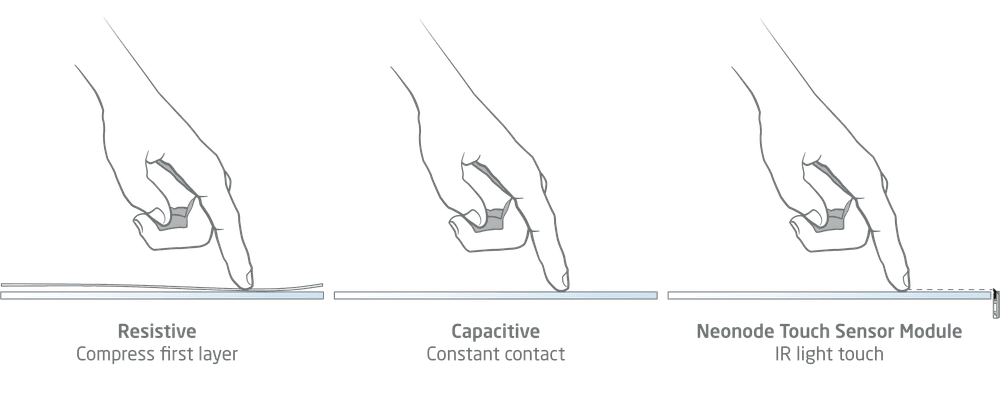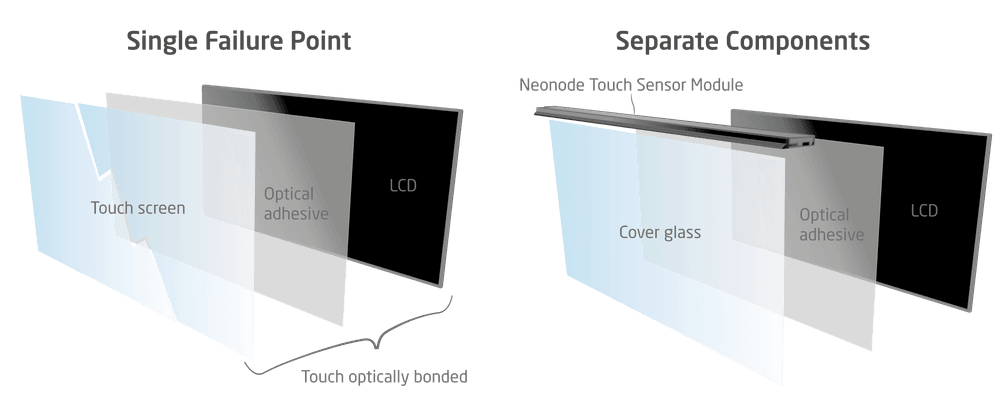Cookie settings

Simplify Touch Integration With The One-sided Sensor
When integrating touch functionality into commercial products, consumer-grade options are not always the best choice. With a single sensor, Neonode enables manufacturers to create touch interfaces with improved reliability and better optics, even in harsh and rugged conditions.
Touch screens are no longer a novelty but are commonplace in thousands of everyday devices from mobile phones, tablets, and appliances. Since the touch interface has become so common in everyday life, touch has also found its way into many not so common applications such as battlefield displays, industrial machine controls, farming equipment, avionics and even spacecraft. Most product design engineers are therefore very familiar with the pros and cons of touch technologies, especially in the case of projected capacitive and resistive touch technologies. These technologies are very mature and have evolved significantly, decreasing in price while improving in performance and functionality.
The advancements in technology, however, have been driven mainly by its use in consumer electronics and therefore the technology has been optimized for the consumer market. Capacitive touch is quite good in our favorite devices and we live with some of the not so perfect drawbacks. But using these technologies in industrial and commercial applications are not always a good fit.
In fact, often commercial devices are limited by the consumer grade technology and require additional enhancements to function in the environment in which they are intended to operate. In this case, display integrators have a collection of available tools for adapting the consumer technology for commercial and industrial applications. These include EMI shielding and gaskets to isolate the capacitive field and enhancement films, optical bonding and supped up backlights to offset for the hit on optics from the ITO coatings. But all these solutions have drawbacks; mainly in reduced performance, diminished optics and usability, all while increasing integration complexity and cost.
There is another option.
What if you could simply place a thin sensor, only 3mm thick, down one side of the display and create a touch interface that requires no additional assembly steps, no optical bonding, no shielding, no tuning, and no calibration?
What if you could maintain a flush surface to satisfy design aesthetics while offering a surface that is easy to clean and to protect against surface contaminants?
What if you could use polycarbonate as a vandal shield? And what if you could separate the display from the touch sensor to allow for easy field replacements in the event some knucklehead does hit the display with a baseball bat?
What if you could accommodate a unique display size without coughing up 100s of thousands of dollars in NRE costs and MOQs? What if you could offer unique display sizes for say retrofitting a resistive 20x8 aircraft display or replacing a 4:3 CRT with an touchscreen LCD in low volumes?
So, what are we talking about? The technology is called Neonode zForce® and it is based on using infrared light, but instead of looking for blocked light as in the case of traditional infrared frames, it uses reflectance. Neonode zForce technology is neatly packaged in our Touch Sensor Modules which are available at low cost and will operate in even the most challenging environments.
What are the advantages?
Ease of Integration:
One of the biggest issues with integrating capacitive sensors relates to the capacitive field -the balance of improving detection without creating more noise or being affected by electrical noise. It is tricky. Solutions include foil, gasketing and even more ITO coatings. All these things cost money and time, as well as additional design and assembly effort. It also means that a capacitive sensor cannot simply be integrated into an enclosure during assembly and expected to work without additional fiddling.
The Neonode Touch Sensor Module is not affected by electrical noise and can be placed directly against metal surfaces including the bezel and side of the LCD enclosure. No tuning or shielding is required.

Another advantage is the Touch Sensor Module itself. It is fully enclosed and self-contained without a separate controller. There is no need to find an acceptable location for the controller in the display stack since the sensor itself contains the electronics necessary for its operation.
The standard interface works out of the box as an USB HID interface or an embedded interface such as I2C.
Better Optics:
Resistive and capacitive sensors are comprised of layers of materials and coatings that reduce light output from the backlight. These coatings also distort images and even reflects light between the layers which further degrades the display. While there have been significant improvements in transmissivity and optical coatings, it is still another layer that removes, distorts and even color shifts images. In addition, the improved optics of these sensors is achieved from optical bonding which fuses two previously independent parts into one failure point.
The Neonode Touch Sensor Module sits on the side, any side, of the display and in no way affects the quality of the display. No additional layer means more light output from your backlights, saving power and reducing heat. It also means no degradation of the display optics.
Improved usability:
Capacitive sensors require a path to ground to register touch and in most cases, this is your bare finger. Yes, gloves will work with proper tuning, but this comes with an offset in accuracy or additional noise. Resistive, on the other hand, requires a compression of the top layer to detect touch. Both are not ideal for smooth swipes and drag operation.

Neonode Touch Sensor Modules have a sub millimeter detection height on the surface of the display. This means that drag operations are intuitive and smooth since it is more forgiving and does not require compression or constant contact to track your finger. This enhances features like fluid scrolling and navigation.
Ruggedization:
Most touch screen overlays offer very little in case of vandal protection of the display in that they are merely as thin as possible to improve optics. There is a limit to the thickness of the glass substrate that projected capacitance can work through and it utilizes a thin piece of glass or polycarbonate as its first surface. And to make things even more challenging, if the sensor is bonded to the display to improve optics, they cannot be easily separated and you end up with two costly components that must be replaced.

Placed on the edge of the display, Neonode Touch Sensor Modules are independent of the display. This means design engineers are free to choose any substrate overlay to protect the display and if it is broken, the overlay can be swapped out in the field without replacing the LCD or recalibrating the touch screen.
Extreme Environments:
Analog based touch screens drift with temperature, humidity, and pressure changes. Again, vast improvements have been made here technologically but the larger the display, the more this becomes an issue. Touch screens prefer benign environments and start to suffer in extreme environments which means that touch icons can become misaligned or touch points not recognized.
Neonode Touch Sensor Modules are optical. They are unaffected by changes in temperature, humidity, or pressure. The sensor modules can be sealed against dust and water with a thin cover lens no more than a few millimeters high and becomes integral to the bezel and simplifies the assembly.
Unique functionality
Contactless Touch – Post COVID, we are still concerned about surface contaminants and public touch displays can be a source of pathogens. Since the sensor detection is parallel to the surface of the display, it can be located above the display at any distance to offer in air interaction without ever touching the screen below. It could also be used in conjunction with other touch sensors to offer both surface and non-surface touch options.
Sensor Fusion – sensor fusion is the notion of combining several sensors together for improved functionality. Examples include:
Wake on approach – Some applications use wake on approach to switch content from say advertising mode to an order menu. Another implementation might enlarge icons or present more personalize content based on proximity to the display. The Neonode Touch Sensor Module can be used to detect the intention of touch from any distance from the surface of the touch allowing for designers to change display modes based on the intention to touch.
Redundancy – Mission critical applications need back up systems to ensure operation of crucial functions. In military avionics, touch displays could be offered that have two independent touch interfaces. Say for instance, keep the legacy resistive touch sensor and add a backup system using a Neonode Touch Sensor Module. Either one could be turned on and off or could work together offering a seamless backup system if the traditional touch stops working.
Confirmation of touch – Unintended touch can be infuriating, or could even be catastrophic, depending on the application. No touch screen technology is foolproof, but touch is still used in some challenging applications that need an accurate indication of interactivity. Since capacitive detects touch in a very different way than a Neonode Touch Sensor Module, the two sensors together could be used to confirm that a touch is registered to resolve for say a ghost touch from a stray EMI source in a medical diagnostic machine.
Granted, for applications where you can use a capacitive sensor, you are probably going to use a capacitive sensor. But in cases where you need gloved operation, or you cannot tolerate any electrical noise (i.e. medical diagnostics) or for applications that need to survive an unattended environment – capacitive may not be your best choice. An alternative to consider for these applications is a Neonode Touch Sensor Module. It can be placed on the edge of the display, simplifying integration, preserving display optics, enhancing performance, and offering unique features that other touch sensors cannot provide such a redundancy, touch confirmation and wake on approach.
Download Touch Technology for Commercial Applications Brochure